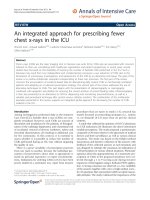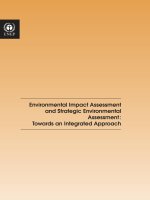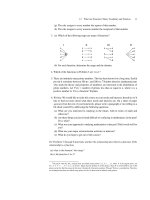developing an industrial chemical process an integrated approach
Bạn đang xem bản rút gọn của tài liệu. Xem và tải ngay bản đầy đủ của tài liệu tại đây (3.8 MB, 230 trang )
An Integrated Approach
DEVELOPING
INDUSTRIAL
CHEMICAL PROCESS
an
Copyright © 2002 by CRC Press LLC
CRC PRESS
Boca Raton London New York Washington, D.C.
Joseph Mizrahi
An Integrated Approach
DEVELOPING
INDUSTRIAL
CHEMICAL PROCESS
an
Copyright © 2002 by CRC Press LLC
This book contains information obtained from authentic and highly regarded sources. Reprinted material
is quoted with permission, and sources are indicated. A wide variety of references are listed. Reasonable
efforts have been made to publish reliable data and information, but the author and the publisher cannot
assume responsibility for the validity of all materials or for the consequences of their use.
Neither this book nor any part may be reproduced or transmitted in any form or by any means, electronic
or mechanical, including photocopying, microfilming, and recording, or by any information storage or
retrieval system, without prior permission in writing from the publisher.
The consent of CRC Press LLC does not extend to copying for general distribution, for promotion, for
creating new works, or for resale. Specific permission must be obtained in writing from CRC Press LLC
for such copying.
Direct all inquiries to CRC Press LLC, 2000 N.W. Corporate Blvd., Boca Raton, Florida 33431.
Trademark Notice:
Product or corporate names may be trademarks or registered trademarks, and are
used only for identification and explanation, without intent to infringe.
Visit the CRC Press Web site at www.crcpress.com
© 2002 by CRC Press LLC
St. Lucie Press is an imprint of CRC Press LLC
No claim to original U.S. Government works
International Standard Book Number 0-8493-1360-0
Printed in the United States of America 1 2 3 4 5 6 7 8 9 0
Printed on acid-free paper
Library of Congress Cataloging-in-Publication Data
Catalog record is available from the Library of Congress
1360_frame_FM Page 4 Friday, May 3, 2002 12:48 PM
Copyright © 2002 by CRC Press LLC
Preface
This book presents a detailed discussion of the issues that have to be
addressed, in most cases, in the development and the first implementation
of a novel industrial chemical process.
These issues start with the “whys” and “wheres,” then address the
working organization and all the different steps, activities, and reviews in
the process development program, and finally in the implementation, design,
construction, and start-up of a new plant.
Why is such book needed at all?
This specific field of activity is constantly occupying many thousands of
managers, scientists, engineers, chemists, specialists, economists, and tech-
nicians. These professionals work in industrial corporations, research orga-
nizations, universities, engineering companies, equipment suppliers, statu-
tory public functions, to name a few, in many countries around the world.
The result of their activity has been hundreds of new processes and new
plants in the chemical industry every year.
Nevertheless, at present, there seem to be no recognized professional
standards, no generally accepted written procedures, or even a book cover-
ing this professional field. Quite different working practices are implemented
in different corporations and in different countries. Thus, any professional
who encounters some of these issues for the first time in his job can only
rely on the direct teaching of his boss and colleagues. And in that lottery
some have more luck than others. Strangely enough, up until now, the know-
how in this important professional sector has been transmitted only by
“apprenticeship.”
Somehow, novel processes have been finally developed and used in new
plants that have been built and operated, most of them successful. But, on
the other hand, many case stories are widely spread in the profession about
all the associated problems, serious waste of time and resources, start-up
troubles, and occasionally complete failures.
These problems have been generally attributed to personal errors in
specific situations, possibly to the individualistic characters of the inventors
and promoters, and to the opportunistic demand for quick results in new
processes. Such explanations could only be true for the initiation stage
1360_frame_FM Page 5 Wednesday, May 1, 2002 3:40 PM
Copyright © 2002 by CRC Press LLC
(possibly 5% of the efforts invested), but cannot hold for all the development
and implementation work. So, a systematic study of the common aspects
to most projects can be instructive.
This book is intended primarily for those professionals who are already
on the job in real life, to help them, hopefully, to do a better and more efficient
job, to be happier by understanding more about what is going on around
them, and to reduce the frustrations associated with this line of work. It is
assumed that the readers will be graduates with some professional experi-
ence, who have access to all the textbooks, handbooks, and publications
available, to Chemical Abstracts and to the Internet, and who know how to
use these. So, this book will not be competing with these sources and will
not copy what is readily available. At most, it will refer the readers to the
more useful sources, in this author’s opinion. The suppliers of commercial
services have essential contributions to such projects, and the general issues
connected with the selection of such suppliers are discussed, but no partic-
ular reference is given as far as possible. The other references direct the
readers, who may be interested in any of the example cases mentioned, to
more detailed sources.
Also, in this book, with due apologies to the chemists, a chemical process
does include any physical or mechanical transformation or separation which
is necessary to obtain the final products.
On the face of it, the development and implementation of a new chemical
process may appear to be a matter of chemistry, materials, equipment, con-
trol, etc., but it should be recognized that this is a very complex endeavor,
and its success depends, in fact, mostly on the interactions and organization
of many different people in various positions.
In each such project, hundreds of professionals are concerned, full-time
or part-time, with the research organization, the various functions in the
corporation, the engineering company, the equipment suppliers, patent
attorneys, specialist consultants, and civil servants with statutory functions.
These professionals are mostly chemical engineers, but all the related pro-
fessions are also involved: managers (in particular in finance, production,
and marketing), different fields of engineers, research and analytical chem-
ists, various specialists, patent attorneys, lawyers, economists, and support-
ing technicians.
The first need in a new project organization is to establish a common
communication and reference system in which every participant in the
project will understand the point of view, the priorities, and the “jargon” of
the others. This aim can require both patience and goodwill from everyone
concerned and should be motivated by the example of the management.
It is hoped that this book can be used for such purposes. The author has
been occupied in this field of activity all of his professional life in many
different positions. He strongly believes that a project involving the devel-
opment and implementation of a new chemical process can be done better
and more efficiently if:
1360_frame_FM Page 6 Wednesday, May 1, 2002 3:40 PM
Copyright © 2002 by CRC Press LLC
• All the issues and all the interactions were discussed and understood
from the beginning by all the participants
• The limits of responsibility were clearly defined
• A proper organizational structure and adequate programs were used
The detailed recommendations in this book can be readily integrated,
without any contradiction or competition, with the latest trends in corporate
research and development (R&D) management procedure, such as the “Stage
Gate” system and similar tools, which recently have been introduced in
many large corporations. These detailed recommendations can assist the
“Gate Keepers” in defining the “deliverables” and “criteria” to be achieved
in the next “Stage.”
All the engineers, scientists, and managers concerned with the develop-
ment of a novel industrial chemical process, and/or with the implementa-
tion, design, construction, and start-up of a plant based on this process, can
use this book to assist them in their work. The book will give them a general
overview of all the issues ahead, and also provide them with checklists to
draw up their own working programs, or at least understand the logic of
the instructions given to them by their boss.
Friends with experience have remarked that the scope of this book may
appear to be very complex and its “message” may be confusing for rapid
readers sampling here and there. Therefore, it was decided to add at the end
of each chapter a short recapitulation of the issues that can be worth an
additional thought and possibly further reading or discussion.
At least, the core team of a project would benefit from a systematic study.
Evidently, not everyone would be interested in all issues at one specific time,
but it is nice to know that they can come back and consider more intensively
any pertinent issue whenever they might face the need. Professionals with
a few years of experience in this field, who may recognize some of the issues
discussed from personal exposure, should benefit more.
Part of the material in this book can also be used as a basis for an overall
course for graduate students who are intending to start their work in indus-
trial R&D, equipment development, process engineering, plant design, and
managing functions in industrial corporations. It also can be used for work-
shops of continuing education for these working professionals.
Obviously, one could have filled the book with examples from actual
projects, but it is debatable whether more such particular examples would
have helped illustrate the points or distract attention from the complex
issues. Furthermore, most of the examples are covered by commercial secrecy
and cannot be published. So, the compromise chosen here by the author may
not satisfy every reader.
The author will be pleased to receive any comment or suggestion that
can help expand the usefulness of this book.
1360_frame_FM Page 7 Wednesday, May 1, 2002 3:40 PM
Copyright © 2002 by CRC Press LLC
The author
Dr. Joseph Mizrahi
was born in 1933 and lives in Israel since 1951 at 27A
Einstein Street, Haifa, 36014, phone (972-4) 824-4431, office phone (972-4)
826-0737, fax (972-4) 826-0797, email He holds
B.Sc. and M.Sc. degrees in Chemical Engineering and a D.Sc. in Mineral
Engineering from the Technion, Israel Institute of Technology in Haifa. In
addition, he received the Diploma of Imperial College, London, 1965, and
the professor-equivalent grade of Research Institutes Scientists. He also
taught and was a postgraduate supervisor part-time at Technion from 1956
to 1979.
Dr. Mizrahi has published 14 papers for international scientific confer-
ences, 29 papers in international journals, has received 20 patents, and 24
communications to various professional conferences.
He worked at the IMI Institute for Research and Development in Haifa
from 1958 to 1974, first as a research engineer, then as head of the Chemical
Engineering Department. His work included basic engineering design for
process implementation, engineering aspects of licensing agreements, anal-
ysis of new processes, economic evaluations, surveys, worldwide liaison
with engineering companies, piloting of new processes, run-in of new plants
in foreign countries, and development and testing of new industrial contact-
ing equipment. In addition, fundamental research was done under his super-
vision and published in the fields of mixing and separation of liquids and
of hydrochloric acid technology.
From 1974 to 1978, Dr. Mizrahi was Managing Director of Miles-Israel
Ltd. in Haifa, a subsidiary of a multinational corporation in food, pharma-
ceutical, and speciality chemicals. This work included the completion of new
plants, the introduction of new products to the world markets, and the
stabilization and diversification of operations.
From 1979 to 2001, he provided independent professional consulting
services to corporations worldwide in the fields of organization and stream-
lining of R&D programs; consolidation, evaluation, and transfer of know-
how; initiation, organization, and evaluation of projects; process design of
new plants; troubleshooting and expansion of existing plants; and analysis
of corporate development strategy.
1360_frame_FM Page 9 Wednesday, May 1, 2002 3:40 PM
Copyright © 2002 by CRC Press LLC
Acknowledgments
This book is dedicated to my wife, Sara, for a lifetime of motivation and
support.
I would like also to acknowledge:
• The influence of Professor Avram Baniel from whom I learned very
much in various forms of collaboration in many projects over more
than 4 decades, since he founded and managed the pioneer team
at the IMI Institute for R&D where I spent the first 16 years of my
professional career.
• The friendly and helpful reviews of the draft of this book by Ari Eyal,
David Gonen, Chanoch Gorin, David Meir, and Tuvia Zisner.
• The long and productive interaction over all my professional life with
a large number of my friends and colleagues in many countries, the
names of whom I cannot list in this limited space.
1360_frame_FM Page 11 Wednesday, May 1, 2002 3:40 PM
Copyright © 2002 by CRC Press LLC
Contents
Chapter 1 Why a new industrial chemical process could be needed?
1.1 Changing world
1.2 A better quality product
1.3 Lower cost of production
1.4 Different raw material
1.5 Ecological pressure
1.6 New products for the corporation
1.7 Newly available industrial technology
1.8 New functions for new products
1.9 Corporate public image
1.10 Worth another thought
References
Chapter 2 Starting the development of a new process
2.1 Driving forces
2.1.1 Backing of a large corporation
2.1.2 Promoting group
2.1.3 The second part
2.1.4 Public authorities
2.2 How a new process is born
2.2.l Normal research and development activity
2.2.2 Personal motivation
2.2.3 Corporate function
2.2.4 Financial and commercial rewards
2.2.5 False starts
2.3 Explicit definition of the development project
2.3.1 Objectives and purposes
2.3.2 Patents
2.3.3 Possible industrial framework
2.3.4 Timetable
2.4 Different stages of a typical program
2.5 Corporate management procedures for new projects
2.6 Worth another thought
1360_frame_FM Page 13 Wednesday, May 1, 2002 3:40 PM
Copyright © 2002 by CRC Press LLC
Chapter 3 Essential resources needed for the development project:
preceding implementation
3.1 Introduction
3.2 Specific managerial skills
3.3 Core project team
3.4 R&D laboratories and pilot installations
3.4.1 Company’s own laboratory and pilot installations
3.4.2 Outside laboratories and pilot installations
3.4.3 Analytical laboratories
3.5 Experts on marketing and on potential users
3.5.1 Particular terminology
3.5.2 Clients’ needs
3.5.3 Competition
3.6 Support from experts on hardware
3.6.1. Plant engineering and operation
3.6.2 Equipment design
3.6.3 Corrosion in construction materials
3.6.4 Operation and process control
3.7 Support from experts in software
3.7.1 Publication search and analysis
3.7.2 Intellectual property and secrecy
3.7.3 Patent application
3.7.4 Process modeling
3.8 Safety, public regulations, and waste disposal support
3.8.1 Safety
3.8.2. Public regulations
3.8.3 Waste disposal
3.9 Support of specific codes relevant to plant design
and operation, and product quality
3.10 Economics
3.11 Development expense budget
3.12 Worth another thought
References
Chapter 4 Actual case examples
4.1 Nature and man: the Dead Sea
4.2 Magnesium chloride-based industries
4.3 Economic uses for the HCl by-product solutions
4.3.1 Strategic policy
4.3.2 Coupling of HCl-producing and consuming plants
4.3.3 Timing of implementation
4.3.4 Production of pure phosphoric acid
4.3.5 Technological difficulties
4.3.5.1 Materials of construction
4.3.5.2 Safe, stable conditions for solvent extraction
in large mineral plants
1360_frame_FM Page 14 Wednesday, May 1, 2002 3:40 PM
Copyright © 2002 by CRC Press LLC
4.3.5.3 Clean starting solution
for solvent extraction
4.3.5.4 Recovery of the residual solvent from
different exit streams
4.3.5.5 Large-capacity liquid–liquid contacting
equipment
4.4 Phosphoric acid diversification processes
4.4.1 Different quality specifications
4.4.2 Solvent extraction opening
4.4.3 IMI “cleaning” process
4.4.4. “Close-cycle” purification process
4.4.5 Mixed process
4.4.6 New proposals
4.5 Citric acid by fermentation and solvent extraction
4.5.1 Conventional lime sulfuric acid process for citric acid
4.5.2 IMI-Miles solvent extraction process for citric acid
4.5.3 Newer solvent extraction process for citric acid
4.6 Preparation of paper filler by ultra-fine wet grinding
of white carbonate
4.7 Worth another thought
References
Chapter 5 Process definition and feasibility tests
5.1 Translation of the idea into a process definition
5.1.1 Scope of the preliminary process definition
5.1.2 Comprehensive literature survey
5.1.3 Block diagram
5.1.4 Quantitative definitions of the different sections
5.1.5 Process calculations for the preliminary
process definition
5.1.6 Presentation of one feasible
implementation formula
5.1.7 Possible industrial implementation framework
5.1.8 Timetable
5.1.9 Important note
5.2 Critical and systematic review of the process definition
5.2.1 Review forum
5.2.2 Fundamental process issues
5.2.3 Patent situation
5.2.4 Profit potential
5.3 Design and execution of the feasibility tests
5.3.1 Purposes of the feasibility tests
5.3.2 Equilibrium conditions
5.3.3 Scale up of reactors
5.3.4 Physical separation operations
5.3.5 Scale-dependant and dynamic flow operations
5.3.6 Extreme conditions
1360_frame_FM Page 15 Wednesday, May 1, 2002 3:40 PM
Copyright © 2002 by CRC Press LLC
5.3.7 Actual raw materials
5.3.8 Analytical difficulties
5.4 Analysis of the results from feasibility tests
5.5 Second review of the process definition
5.6 Worth another thought
References
Chapter 6 Experimental program
6.1 Basis
6.1.1 Experimental program purposes
6.1.2 Different sections
6.1.3 Quantitative data needed for process design
6.1.4 Format
6.1.5 Representative raw materials
6.1.6 Classification of missing data
6.2 Chemical equilibrium data
6.2.1 Vapor–liquid equilibrium system
6.2.2 Gas–liquid equilibrium system
6.2.3 Liquid–liquid equilibrium system
6.2.4 Solid–liquid equilibrium system
6.2.5 Reversible and nonreversible equilibrium
6.2.6 Chemical equilibrium laboratory tests
6.2.7 Experimental difficulties in chemical
equilibrium tests
6.3 Dynamic flow conditions
6.3.1 Design data required
6.3.2 Simpler processes
6.3.3 Theoretical models
6.3.4 Special test rigs
6.3.5 Indirect methods
6.4 Scale-dependent operations
6.4.1 Vertical driving force depending
on the hydrostatic height
6.4.2 Wall effect
6.4.3 Crystallizer
6.4.4 High-temperature equipment
6.4.5 Failure to recognize the wall effect
6.5 Reporting results from the experimental program
6.5.1 Frequent partial reports
6.5.2 Complete reports on the experiment part
6.5.3 Implications of the results
6.6 Worth another thought
References
Chapter 7 Preliminary process design for a particular proposal
7.1 Process team
1360_frame_FM Page 16 Wednesday, May 1, 2002 3:40 PM
Copyright © 2002 by CRC Press LLC
7.2 Process flow-sheets
7.3 Preparation of an overall detailed description
7.4 Listing of all the main process streams
7.5 Material and heat balances
7.6 Material handling operations
7.7 Summary tables for all required services
7.8 Major pieces of process equipment
7.9 Main operational and control procedures
7.10 Listing of required staff
7.11 Worth another thought
Chapter 8 Economic analysis of the specific proposal
8.1 Purpose
8.2 Preliminary estimate of the Fixed Capital
investment (revision 0)
8.3 Estimate of operating costs
8.4 Expected net sales income estimate
8.5 Profitability calculation
8.6 Optimistic evaluation of the profit potential
in other applications
8.7 Possible synergetic effects with other production facilities
8.8 Comprehensive report for the justification
of the specific proposal
8.9 Contractual agreements
8.10 Worth another thought
References
Chapter 9 Working program toward a first implementation
9.1 Patent protection
9.1.1 Revised or additional applications
9.1.2 Extended geographical coverage of the patents
9.2 Detailed process design
9.2.1 Piping and Instrumentation Diagrams
9.2.1.1 Piping lists
9.2.1.2 Valves
9.2.1.3 Instruments
9.2.1.4 Control loops
9.2.1.5 Flanged manholes and hand-holes
in closed pieces of equipment
9.2.1.6 Provisions for possible future connections
9.2.1.7 Non-conventional drives
9.2.2 Examples of portions of piping
and instrumentation drawings
9.3 “Major” equipment packages
9.4 Pilot testing of specific process operations
9.4.1 Multiple-effects evaporator
1360_frame_FM Page 17 Wednesday, May 1, 2002 3:40 PM
Copyright © 2002 by CRC Press LLC
9.4.2 Liquid–liquid contacting battery
9.4.3 Main problems for piloting
9.5 Modeling
9.6 Complementary bench-scale testing program
9.6.1 Detailed specification of the industrial equipment
9.6.2 Pilot installations
9.6.3 Process modeling
9.6.4 The design of instrumentation
9.6.5 Corrosion tests
9.6.6 Clarification of waste disposal issues
9.6.7 Clarifying process safety issues
9.7 Preparation of product samples for market field tests
9.8 Clarification concerning any formal permits needed
9.9 Worth another thought
References
Chapter 10 First implementation plant design: compromises
and optimization
10.1 “First implementation” policy
10.1.1 Expected start-up problems
10.1.2 Design policy
10.1.3 Identifying probable causes of problems
10.1.4 “Guarantees” for reasonable plant performance
10.2 Modeling and optimization
10.2.1 Composition of raw materials
10.2.2 Effects of impurities
10.2.3 Changes in the kinetics of mass transfer
10.2.4 Changes in specifications for the final product
10.2.5 Normal fluctuations around the designed average
10.2.6 Differences in the performance of equipment
10.3 Critical pilot testing
10.4 The process package
10.5 The role of the engineering company in the first
implementation of a novel process
10.5.1 The interests and limitations
of the engineering company
10.5.2 The engineering company and the project manager
10.5.3 Specialization
10.5.4 The chemical process engineering department
10.5.5 Timetable
10.6 Detailed engineering documents
10.7 Final review and approval for construction
10.8 Worth another thought
References
1360_frame_FM Page 18 Wednesday, May 1, 2002 3:40 PM
Copyright © 2002 by CRC Press LLC
Chapter 11 Running in and adjustments in the new plant
11.1 The plant construction period
11.2 Assembling and training the operating team
11.2.1 Recruitment
11.2.2 Maintenance
11.2.3 Training
11.2.4 Safety
11.2.5 Functional organization
11.3 Preparation for start-up
11.3.1 “Dry runs”
11.3.2 The plant manager
11.3.3 The construction manager
11.3.4 The project manager
11.4 Preparation with real materials
11.5 Strategic options for the running-in of the new plant
11.5.1 Possible causes of problems
11.5.2 Unsatisfactory results
11.5.3 Start-up strategies
11.6 Stabilization of production
11.7 Demonstration run and project success report
11.8 Optimization of operating conditions
11.9 Worth another thought
Chapter 12 Consolidation of the new know-how
12.1 Updating the process know-how
12.2 Final revision of the Process Package
12.3 Updating the Operational Manual
12.4 Feedback from users in the market
12.5 Additional patent applications
12.6 New publications
12.6.1 Information on the competition
12.6.2 Publications on the new process and plant
12.7 How can this accumulated specific know-how
be used again?
12.8 A final note: what have we learned?
12.9 Worth another thought
Appendix 1 Typical organization and contents of a Process Package
A1.1 General
A1.2 Definition of “black box” objectives
A1.3 Division of the process into sections as illustrated
in a block diagram
A1.4 Separate discussions for each section
A1.5 Material and heat balances
1360_frame_FM Page 19 Wednesday, May 1, 2002 3:40 PM
Copyright © 2002 by CRC Press LLC
A1.6 Equipment choices
A1.7 Services
A1.8 Materials of construction: options and preferences
A1.9 Safety aspects
Appendix 2 Functional organization structure of a typical
development project
A2.1 Successive stages
A2.2 The invention and promotion stage
A2.3 The process development stage
A2.4 The construction and running-in period
1360_frame_FM Page 20 Wednesday, May 1, 2002 3:40 PM
Copyright © 2002 by CRC Press LLC
chapter 1
Why a new industrial
chemical process could
be needed?
1.1 Changing world
The development of a new chemical process is a major technical, eco-
nomical effort that can be justified only if it fills a definite need of an
industrial corporation. The present chapter discusses the various situa-
tions in which such a need could be defined. This review allows one
connected to the chemical industry to evaluate the probabilities that
his/her corporation would need a new chemical process in the foresee-
able future. There are basic reference books that can be used as sources
for this initial information.
1–5
The chemical industry has always been operated in a
changing world
with
expanding markets, a need for better products at lower prices, change in
raw materials, addition and removal of political barriers, great jumps in the
technology available for industrial application, higher ecology demands, etc.
As time goes on, the dynamic rate of such changes seems to be
increasing
exponentially.
In the past 3 decades, in particular, it requires an open attitude
from any corporate management towards possible process revision.
In such a changing world, an operating chemical corporation could
require a novel process for a certain product, if and when one (or more) of
the
objective
situations discussed below becomes dominant and is recognized,
at least inside the organization. Let us consider first the situation in which
a corporation is already producing and selling the product, but now needs
process changes
for
:
• Obtaining a better quality product
• Reaching a lower cost of production
• Using different raw materials
• Responding to ecological pressures
1360_frame_C01 Page 1 Monday, April 29, 2002 3:32 PM
Copyright © 2002 by CRC Press LLC
A different situation occurs when a corporation is considering making
a new product.
The company will need a new industrial process for:
• Producing according to a soon-to-expire patent
•“Bypassing” an existing patent
• Using a newly available industrial technology
• Creating new markets with a product fulfilling new functions
• Expanding its public image
1.2 A better quality product
The need for a better quality product could be felt in one of the corporation’s
existing markets and reported by the marketing organization. Such a need
could arise from the persistent requests or complains of clients or from the
pressures of competitors’ products, and it could be reflected in the presen-
tation of more stringent standard purchasing specifications. Furthermore, an
upgraded product could open the way to other market segments.
This situation is quite common in the process industry, as a chain result
from changes in the downstream uses of the products. It generally motivates
a continuous effort in limited research and development (R&D) projects,
resulting in
gradual changes
in the existing production technology, in an
attempt to improve the product’s quality as requested. Such an aim could
possibly be obtained, for example, by the addition of
purifying operations
to
the production line, such as distillation, recrystallization, active-carbon
decolorization, ion-exchange purification, and the like, or by
compromising
on the product’s yield
in order to remove more impurities in the wastestreams.
However, in many cases, a point is reached when further improvement
would no longer be possible with the existing process or with the raw
materials presently used, or when such quality improvement would become
too expensive. At this point, the need for a significant process change will
be recognized and defined inside the corporation, and such need could also
be made public in the market segment. This significant process change would
preferably be limited to the
core production process
, while almost all of the
expensive infrastructure could most likely be maintained with minimum
adjustments.
1.3 Lower cost of production
Lower cost of production is, of course, always desirable in any existing plant,
either to increase the profits or to allow lower and more competitive prices.
In practice, in all operating plants, this objective is dealt with continuously
by small and gradual ad-hoc steps, which do not impair the regular flow of
production.
There is not always a direct link between the production cost and the
sale price, and there are even examples of plants that have been supplying
an essential strategic corporate need while losing money. However, many
1360_frame_C01 Page 2 Monday, April 29, 2002 3:32 PM
Copyright © 2002 by CRC Press LLC
operating plants are living under the shadow of the possible development
of a
more efficient, completely new
process with
drastically lower production costs
.
This process may become available to the competition and may endanger
the basic economic existence of the plant. Thus, corporations must always
devote a continuous effort to keeping up to date with all the developments
that could lead in this direction. These include higher yields, lower energy
consumption, shorter route, revaluation of byproducts, etc. This could evolve
into a
full-scale process development effort
, whenever a company intends to
build a new plant to replace an old installation or when stronger protection
is required against the perceived competition.
1.4 Different raw material
In some cases,
different
raw materials may become available that could have
definite technical or cost advantages. In other cases, a significant change
could be expected in the future
quality
or in the
cost
of the raw materials that
are presently used, or even in the continuation of their future supply.
The changing situation concerning the raw materials’ supply has always
characterized those industrial chemical processes that start with
natural
raw
materials, i.e., mineral ores, agricultural crops, or petroleum fractions for the
petrochemical industries. The situation could be even more sensitive when
the raw materials from a plant are
byproducts
or
waste products
from the main
production of another plant that is using such natural raw materials (i.e.,
grain hulls, molasses, mineral concentrate fractions, hydrocarbon streams,
etc.). A similar situation relates to the use of some waste products from the
combustion in large power plants (fly ash from coal, soot, solutions from
ecological scrubbers, etc.) as the starting raw materials.
For example, the world’s main supply of zirconium oxide (and zirconium
compounds) for many decades came from a byproduct (Baddelayite concen-
trate) mined in South Africa. It has been known from the 1990s that this unique
source was progressively and irrevocably being depleted
6
and all the suppliers
and users of zirconium oxide had to urgently look for new processes. The
acute need directed the users’ attention to options for extracting zirconium
oxide from the mineral Zircon (zirconium silicate), which is plentiful world-
wide as a heavy-sand concentrate. Unfortunately for the developers, however,
it also has a very stable mineralogical structure. To overcome this inherent
stability, some proposed the use of brute force, such as fusion in an electric
arc furnace at 2700˚C, followed by volatilization of silica fumes and other
impurities (some of it radioactive) that had to be collected, or thermal disso-
ciation by a shock treatment at very high temperatures in a plasma torch,
followed by a wet treatment. Other proposals were based on sophisticated
chemical detours by additive reactions with calcium or sodium oxide at rela-
tively lower temperatures.
7–10
The recently patented process, developed by
Chanoch Gorin and Joseph Mizrahi
9
for that purpose, presents an efficient
novel route and will be discussed in Chapter 5 as an illustration of several
development steps. The possibility of getting some Baddelayite supply from
1360_frame_C01 Page 3 Monday, April 29, 2002 3:32 PM
Copyright © 2002 by CRC Press LLC
a mine in Russia’s arctic Kola region, along with the rather small world market
(in tons and in sales volume) also represent limiting factors in the development
of these new processes.
In an opposite situation, the exclusive and efficient production of high-
grade synthetic potassium nitrate, according to the 1967 IMI solvent extrac-
tion process,
11
has been a profitable operation for several decades as the
principal worldwide supplier, despite the well-known existence of large
natural deposits of nitrates in South America. Since the mining and refining
operations have finally been established in Chile, the situation in this market
changed throughout the world. Different grades of potassium nitrate are
now available to different users at different costs and the consumption of
the highest quality synthetic product has decreased. All of these changes
called for drastic process reconsideration in the plants using the synthetic
route. Such options for change had been available for at least 10 years,
12–13
but there was no pressing incentive for a development effort.
In the last few decades of the twentieth century, the fluctuations in the
quality as well as the cost or the availability of many raw materials have
often reflected the changes in international trade, as many
political and cus-
toms barriers
were added or removed. Examples of such changes are the
decolonization of many countries, the European Union and other regional
unions, the decentralization of the former Eastern block into separate coun-
tries and the accelerated privatization of their industries, as well as the
increasing role of The Republic of China in all economic areas. All of these
geopolitical changes have seriously affected the way in which many older
chemical plants have been operated for generations, and have forced com-
panies to reconsider their production processes and possibly how to develop
alternative processes more related to the new situation.
For example, raw (brown) cane sugar could be produced somewhere in
Asia, transported to a European city to be refined and recrystallized, and
then reexported around the world. Such activity could only have been devel-
oped in the past generations under the cover of heavy custom tariffs, which
have finally affected the European consumers. But the gradual reduction of
this practice in the future also will affect a series of downstream industries,
which are linked to the byproducts of the sugar refinery in Europe (i.e.,
molasses or low-grade sweeteners). There are many similar examples in
other fields and in other parts of the world.
In addition, the new “global village” economy has led to many international
corporate mergers and other “arrangements” that have affected the distribution
of raw materials in different areas. This presently accepted practice constitutes
a drastic change from the anticartel laws that were taken very seriously until
recently in the American sphere of operation (at least in open references).
1.5 Ecological pressure
Such pressures have been systematically applied in the last generation by
public
organizations and/or by
statutory
regulations in developed countries, to reduce
1360_frame_C01 Page 4 Monday, April 29, 2002 3:32 PM
Copyright © 2002 by CRC Press LLC
as much as possible the environmental damages caused by some existing chem-
ical plants. In many cases, serious cleanup operations have been successful and
all concerned, including the employees of these plants, were much relieved.
In other situations, the response of the chemical industry to such pres-
sures has been to “do something” that is not too expensive (mostly down-
stream effluent treatments), and to claim to have done “everything possible,”
except for the ultimate closing of the plant, which is generally not desired
by the community. In this continuing struggle, both sides are progressively
improving their knowledge as more experts are called in. An underlying
menace, however, is the occasional threat to move an industrial activity to
another part of the world where ecological pressures are less demanding.
In many situations, a mutually acceptable solution would evolve from
a
change in the source or quality of the raw materials
. This would require a
significant change in the main process, while retaining the plant’s entire
expensive infrastructure. In such a case, the development of the new process
has to be done within strict boundaries, but the know-how developed could
eventually be applied in future plants.
Another aspect of the ecological pressure relates to the combustion gases
from fuel burning, either in cars or power stations. The effluent gases from cars
have been dealt with more efficiently, in particular by auto industry improve-
ments and through the supply of cleaner fuels from the petroleum refining
industry. This necessitated the development of many new chemical processes
(most of them still not published). This solution is not feasible for power
stations, which are using mostly coal and the residual “dirty” petroleum heavy
fractions. There an additional treatment must be done on the effluent gases on
the way to the chimney to separate the SO
2
/SO
3
, NO/NO
2
, particulate matters,
and possible poisonous metallic traces. Such treatment is complicated (from
the chemical and technology points of view) and expensive, because gases need
to be cooled and then saturated with water vapors. The resulting heavy white
“plume” from the chimney would be much more visible and of concern to the
surrounding population. This could also be corrected with the use of more
heating and pressure, which would result in more energy and higher costs. If
the chemical industry participated in such efforts, they could recover part of
the costs from the marketing of, for instance, valuable ammonium sulfate and
nitrate of fertilizer grade produced from the treatment of effluent gas. Many
processes were proposed along these lines and are actively being considered,
however, actively but slowly by the power station operators. (No references
are given here, considering the actual commercial interests.)
1.6 New products for the corporation
Let us consider now the situation in which the corporation has not been
producing and selling the product, or a new corporation that is organized
for such project.
A corporation may have been prevented from entering into a specific
production line that was well protected by a competitor’s existing patent. Such
1360_frame_C01 Page 5 Monday, April 29, 2002 3:32 PM
Copyright © 2002 by CRC Press LLC
patents could cover either the nature (analysis, specification) of the product
or a specific production process for such product. These are different issues.
If the existing patent covers the
nature
of the product
, a
process develop-
ment effort
would be required as soon as it is established that such
patent
would expire
in
a few years, or if a way to
by-pass
such protection can be
proposed (e.g., by a small change in the formula that does not affect the
performance). Note that the patent law prevents only the selling of the
product covered by the patent, not the study or the preparation for its
eventual production or even its production for storage. This situation has
been typical, in particular, to the pharmaceutical industry, as so-called
generic
medicines are sold in the marketplace at reduced prices as soon as
the basic patent covering the
trademark medication
has
expired. This same
tactic relates to the fine chemicals industry, producing patented chemical
specialties, additives, resins, catalysts, etc.
A patent covering a
specific production process
can generally be
extended
on and on, by additional filing of complementary patent applications based
on the specific practical know-how that has been accumulated during the
plant’s operation. This technique is not always effective, but it is widely
used, mostly as a deterrent toward weaker, would-be competition. On the
other hand, if such a competitor has a strong incentive and a good R&D
team, a serious effort could possibly indicate some ways to avoid the formal
definitions in the claims of these complementary patent applications. This
would collapse the whole patent protection. (See the case of citric acid
production discussed in Chapter 4, Section 4.5.)
1.7 Newly available industrial technology
Generally, whenever a
new industrial technology
has become available from
an
external source supplying other industries
,
typical opportunities
for new pro-
cess developments should be investigated. Such new technology could be
applied to the potentially profitable production of desired products, which
previously could not be produced economically.
The timely recognition and
exploitation of such opportunity is one of the main challenges of industrial R&D.
As a classical example, the
solvent extraction technology
has been
researched, applied, and refined
as an industrial separation/purification tool
in the 1940s and 1950s. This was due to the
urgency nuclear applications
at the
time; however, on a relatively small scale. When the essential basis of this
technology became publicly available in the 1950s, it was recognized as a
powerful separation tool by many of the best R&D leaders in the chemical
scientific profession. Its potential uses were intensively and competitively
studied by many faculties and institutes and discussed in successive inter-
national conferences. The various proposals for processes and contacting
equipment then were developed further and patented in an all-out race by
those in the fields of chemical processing, pharmaceuticals, petrochemicals,
fertilizers, and hydrometallurgy, resulting in dozens of highly profitable
industrial processes and enterprises by the late 1970s.
1360_frame_C01 Page 6 Monday, April 29, 2002 3:32 PM
Copyright © 2002 by CRC Press LLC
The so-called “energy crisis” of 1973 prompted many fundamental studies
on the more
efficient production and use of energy
, and particularly in the chemical
industry. Many old-fashioned processes and equipment were then condemned
as utterly inefficient and, after intensive scientific and technological develop-
ment, were replaced eventually by new solutions. Many new equipment mod-
els and designs were developed and introduced in the following 15 to 20 years,
and most of these are now considered “standard practice.”
A similar international effort at the time was devoted to the
desalination
of seawater in order to supply potable water to arid areas at a reasonable
cost. Such an intensive effort resulted in improved industrial equipment and
technologies, which are now available on a wide and diverse scale, although
the industrial investments (dependent mostly on public funds) apparently
are still not catching up with the demand. These technologies include, for
example, multistage flash evaporation, multiple-effect distillation with dif-
ferent heater combinations, vapor recompression, reverse osmosis mem-
branes, etc. (See the excellent review of Rafi Semiat in Reference 14.)
However, it is important to remember that these technological develop-
ments should not be classified for a limited “specialized” application. They
could also be the
critical key
for many
new processes in the chemical and bio-
technology industry
that has involved a significant evaporation load, or that
operates sections at widely different temperatures and requires large heat-
ing/cooling exchanges.
Later on, the use of
advanced membranes as separation tools,
of
nano-struc-
tured catalysts,
of
extraction at “supercritical conditions,”
of
the high vacuum
technology,
of
lasers and plasma as focused heat sources,
of
micro-systems,
(to
name a few), have added many new, potent processing possibilities.
Today, the advances in industrial
biotechnology
are notable and already
offering industrial ways to replace many old chemical synthesis processes
and to produce economically some of the large-scale organic chemicals. This
is a direct link to the ongoing progress made by the corn sweetener industry
(mostly in North America) in the industrial uses of enzymes (in particular,
the immobilized enzymes) for producing very pure, defined compounds
from starch or cellulose by chemical and physical processes. (See some basic
references in 15, 16, and 17.)
Many very important applications in the pharmaceutical industries for
very expensive products were handled as a “
lot of small-scale batch production
units
.” The simpler large-tonnage fermentation processes were for a long
time limited to the smaller molecules (ethanol, acetic acid, etc.) and in direct
competition with the petrochemical processing industry, except for food
applications. The large-scale production of citric acid by fermentation
opened the way to more complex products. At present, the biotechnology
R&D handled by the largest corporations aims mainly to large tonnage,
relatively lower cost, and intermediate chemicals for the polymerization of
industrial plastic materials, such as lactic acid as just one example.
18
Of course, any such research project starts with the fermentation biology
in order to select the organism and the conditions in which the desired
1360_frame_C01 Page 7 Monday, April 29, 2002 3:32 PM
Copyright © 2002 by CRC Press LLC
compound can be reliably produced. However, one should note that
any such
fermentation
can only be operated in
relatively dilute conditions
compatible
with the life (osmotic pressure?) of the microorganism. Thus, the desired
compound can only be obtained in a concentration range of 1 to 8% (very
rarely up to 12 to 15%) in the fermentation broth, together with unavoidable
residual contamination from the fermentation media. A quite
expensive con-
centration installation will be needed downstream, together with specific separation
and purification processes, to obtain the final 100% product
.
And this fact-of-life
brings us back to the solvent extraction and/or desalination technologies
mentioned above.
Finally, the electronic computer process control technologies, which
became widely spread in the past few decades, did allow the practical recon-
sideration of some processes that were studied theoretically, but were previ-
ously rated as difficult or even hazardous to control manually (i.e., based on
the operator’s decisions and responses). These are mainly in the petrochemical
field, but also in the classified chemical industry for military applications.
1.8 New functions for new products
A new product could also be needed in the market to fill a
new function
at
the users’ end, resulting from some parallel technological development in
other industries. Whenever the need for such a product can be defined, a
process development and evaluation effort will be justified. Of course, the
silicon chip industry jumps to mind, but there are many more prosaic large-
scale products.
For example, the production of citric acid by fermentation was handled
for many decades as a
pharmaceutical product
on a small scale. However, the
expanding industry for soft drinks and packaged food required more and
more citric acid, until it was treated as a
commodity
and produced in larger
tonnage in continuous plants by a completely different technology.
In a different field, the way in which fertilizers are used in more sophis-
ticated and intensive farming by many developed countries, under ecological
control, has continuously changed. This has called for the supply of more
concentrated, cleaner, multicomponents mixtures
, mostly water-soluble, with less
residual contamination of the soil and underground water layers. The same
principle applies to products in the insecticide and fungicide fields, as the
toxic metals were removed from the formulae and replaced by very specific,
biodegradable, organic components.
The purchase specifications of many of the fine chemical intermediates
used in the mass production of plastic, refractory, and ceramic materials have
also changed significantly to meet the users’ demands. The term “advanced
material” is more and more fashionable these days (although not always
justified) and are interesting and profitable markets that the chemical indus-
try is expected to supply. This would require a significant innovative effort.
For example, a young entrepreneur named Steff Vertheimer started
nearly 40 years ago to study the preparation of small bits of very hard and
1360_frame_C01 Page 8 Monday, April 29, 2002 3:32 PM
Copyright © 2002 by CRC Press LLC









